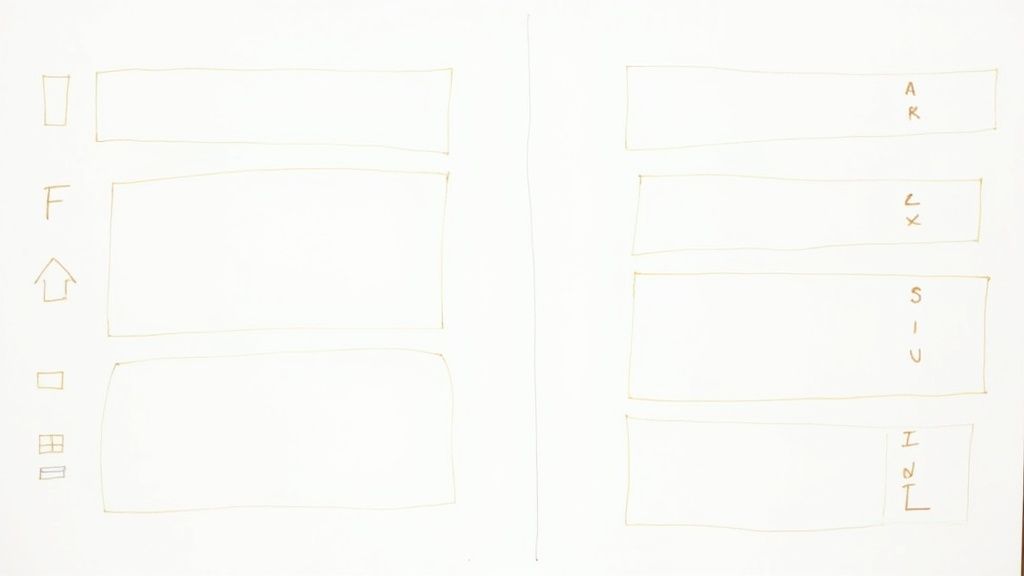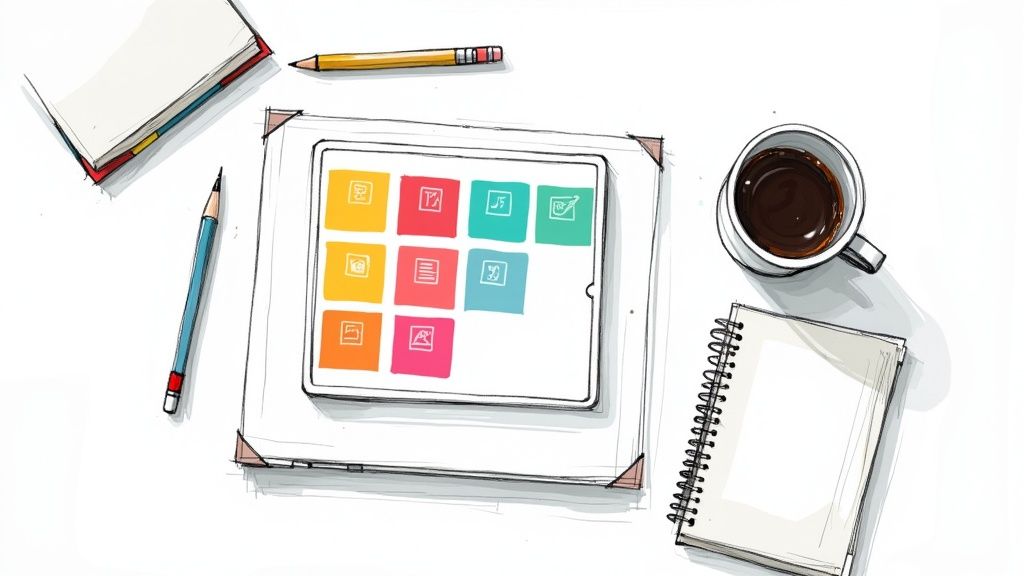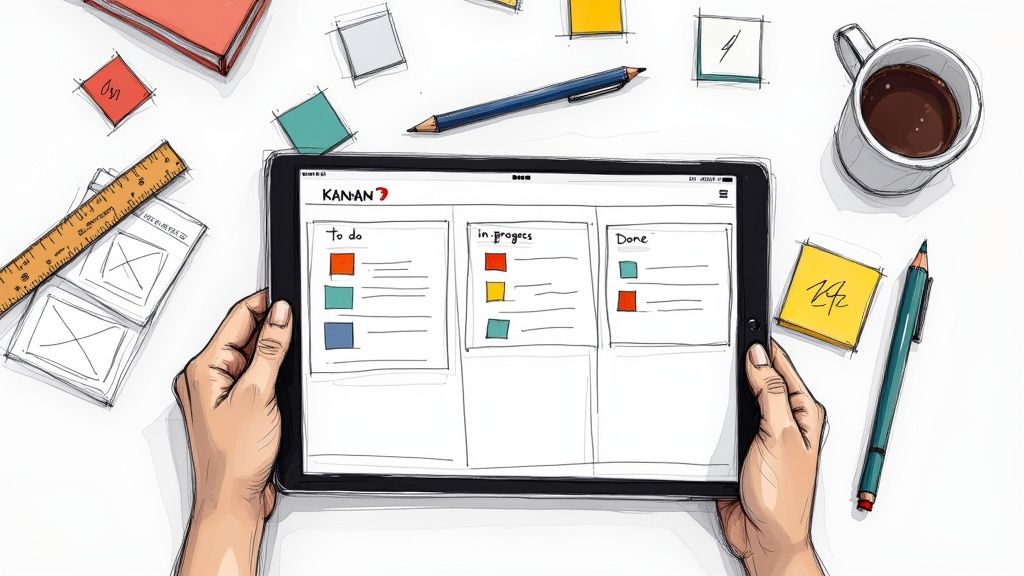Improving team productivity isn't about squeezing more hours out of the day. It's about building an environment where focused, meaningful work can actually happen. Imagine a team where every project kicks off with crystal-clear goals, communication flows effortlessly, and everyone knows exactly what they need to do. That's not a fantasy—it's the result of creating smarter systems that cut out friction and turn busywork into high-impact results.
The Real Cost of Unproductive Teams
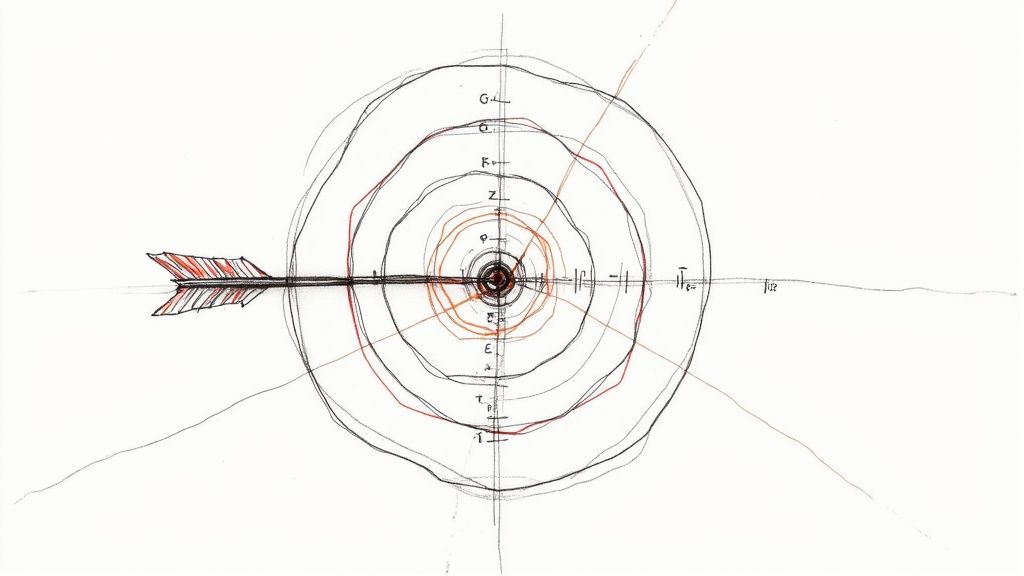
Before we jump into fixing things, let's get honest about what low productivity is actually costing your business. It's so much more than a few missed deadlines. It’s a quiet but constant drain on your finances, stunting growth and slowly chipping away at team morale.
Too many leaders fall into the trap of measuring productivity by hours logged. This is a fast track to burnout, not better outcomes. Real productivity is about maximizing the value created in the time people are working. When teams are bogged down by confusing processes or unclear goals, the ripple effects are huge.
The Hidden Financial Drain
The most obvious hit is to your wallet. Every hour a team member spends on a repetitive task that could be automated, or sits in a pointless meeting, is a direct cost. Picture a developer digging for the right documentation for an hour or a designer waiting two days for simple feedback—these tiny delays add up to massive losses over a year.
And this isn't just a feeling; the numbers are stark. A huge driver of productivity is employee engagement, yet globally, a staggering number of workers report feeling disengaged at work. That widespread disengagement comes with a heavy price tag, leading to billions in lost productivity.
The real challenge isn't making people work harder; it's removing the obstacles that prevent them from working smarter. Every unclear goal, confusing process, and unnecessary interruption is a tax on your team's potential.
The table below outlines some of the most common hurdles that get in the way of high-performing teams.
Key Obstacles Undermining Team Productivity
A summary of the primary challenges leaders must address to build a high-performance environment.
Recognizing these challenges is the first step. The next is to actively dismantle them.
Stifled Growth and Missed Opportunities
Beyond the day-to-day financial drain, low productivity kills innovation. It stops you from grabbing new opportunities. When your team is constantly putting out fires and just trying to keep up, there's zero bandwidth left for big-picture thinking or creative problem-solving. You end up stuck in a reactive cycle, unable to push forward on the goals that truly matter.
Smooth, effective workflows depend on having clear systems and the right tools. One of the most common culprits I see is mismanaged resources—whether it's people's time, their specific talents, or the budget itself. For anyone looking to get their operations in order, checking out the best resource management tools can give you a solid starting point for building a more productive foundation.
Ultimately, figuring out how to improve team productivity starts with admitting the true cost of doing nothing. It’s time to shift the conversation from "working more" to "achieving more" with a lot less hassle.
Cultivate a Culture of High Performance
Let's be honest: the best project management tool in the world won't fix a toxic work environment. A truly productive team isn't just about having the right software; it's about fostering a culture where people feel safe, recognized, and motivated to do their best work. How people feel directly impacts the results they deliver.
Think about two teams for a second. Team A is stuck in a low-trust environment where every mistake is scrutinized and asking questions is seen as a sign of weakness. Then there's Team B, which operates in a high-trust culture where people share ideas freely, own up to errors without fear, and genuinely support each other.
Team A might look busy, but Team B is the one consistently delivering incredible work and solving the toughest problems. Why? Because their environment makes it safe to innovate.
The Manager's Crucial Role
Leadership is everything when it comes to shaping this culture. In fact, a manager's influence can explain around 70% of the variance in how engaged their team is. That's a massive connection between management and output.
Highly engaged teams don't just feel better—they perform better. Studies consistently show they can drive 23% higher profitability and are way more productive in key areas like sales and production. They even build stronger relationships with customers.
So, how can leaders actively build this kind of high-performance culture? It boils down to a few key actions:
- Prioritize Psychological Safety: You have to create a space where your team feels safe enough to take smart risks, voice different opinions, and admit when they don't know something.
- Give Meaningful Recognition: Ditch the generic praise. Acknowledge specific contributions and show your team exactly how their work connects to the bigger goals.
- Model Vulnerability: When leaders admit their own mistakes, it gives everyone else permission to do the same. This fosters a culture of learning instead of a culture of blame.
The most powerful tool for improving team productivity isn't software; it's trust. When people feel trusted and respected, they bring their best, most creative selves to their work.
Practical Steps for Building a Better Culture
Building this kind of environment doesn't happen overnight. It’s not about grand, sweeping gestures but the small, consistent actions you take every single day that build real momentum.
One of the cornerstones of a great culture is simply clear, effective teamwork. By defining and encouraging the right behaviors, you can completely change how your team works together. To see what this looks like in practice, check out these essential teamwork skills examples you can start using today.
And if you're ready to go deeper, it helps to understand the mechanics behind what makes a team truly high-performing. For a fantastic resource on this, dive into these proven strategies to improve team productivity that show you how to build a better environment from the ground up.
When you focus on the human elements—trust, safety, and recognition—you create a resilient culture that becomes your ultimate competitive advantage. This foundation makes every tool and process infinitely more effective.
Eliminate Digital Chaos to Reclaim Focus
In any modern workplace, the constant stream of notifications, pings, and last-minute meetings can create a false sense of productivity. But let’s be honest: this digital noise is the biggest enemy of real, meaningful work. Every single interruption yanks your team out of deep focus, making it nearly impossible to build momentum on the tasks that actually matter.
This isn't just a minor annoyance; it's a massive drain on your team's efficiency. The concept of context switching isn't just theory—it has a real cognitive cost. We don’t just lose the few seconds it takes to glance at a message; we lose the much longer stretch of time it takes to get our heads back into the zone.
The True Cost of Constant Interruptions
Think about a developer deep in code, on the verge of solving a complex problem. A Slack notification pops up—it’s just a quick question—but that tiny interruption shatters their concentration. It's not just the 30 seconds to answer; it’s the 20 minutes it takes to find that flow state again. This happens dozens of times a day.
Research shows that it takes an average of 23 minutes to fully refocus after each disruption. That cycle makes sustained concentration a fantasy and absolutely tanks your team's output. For a deeper dive, check out the 2025 workplace statistics that show how distractions impact modern work.
A productive day isn’t measured by how many notifications you clear. It’s measured by progress. Protecting your team's focus is one of the most direct ways to boost productivity.
To fight back, you have to build a work environment that actively defends against these distractions. That means setting clear, intentional ground rules for how your team communicates.
Practical Steps to Tame the Digital Noise
A great first step is to define the purpose of each communication tool you use. You need to establish crystal-clear guidelines for when to use what.
Here’s a simple, step-by-step way to do it:
- Audit your tools: List every communication tool your team uses (Slack, Teams, Email, Asana comments, etc.).
- Define a primary purpose for each: Create a simple chart that everyone can reference.
- Communicate and commit: Share the new guidelines with the team and get everyone's buy-in.
Here’s a practical example you can adapt:
- Email: Use this for formal announcements, external communication with clients, or weekly summary reports. Response expected within 24 hours.
- Instant Messaging (like Slack or Teams): Reserve this for urgent, time-sensitive questions that are blocking work. Not for general updates.
- Project Management Tools (like Notion): This is the single source of truth. All task-related updates, questions, files, and feedback should live here.
By setting these boundaries, you lift a huge mental weight off your team. They no longer have to guess where to find information or which ping actually needs their attention right now. If you want more guidance on this, our post on revolutionizing task management in Notion has some practical tips you can use right away.
Ultimately, reclaiming focus is all about being deliberate. Run fewer meetings, and make sure the ones you do have come with clear agendas and action items. Encourage your team to block off "focus time" on their calendars. These small shifts can transform a team from being constantly reactive to one that proactively drives results. For more ideas, explore some solid strategies on mastering email productivity.
Make Technology Your Productivity Partner
In a world overflowing with apps and platforms, it's easy to get bogged down. The goal isn't to pile on more tools; it's to strategically choose tech that frees up your team, not creates another source of distraction. Think of technology as an ally that should handle the grunt work, saving your team's brainpower for creative and strategic thinking.
Imagine wrapping up a critical hour-long planning meeting. Instead of someone spending another hour typing up notes and assigning tasks, an AI assistant transcribes the conversation, pulls out key decisions, and drafts a to-do list in minutes. That's how you boost team productivity—using tech to handle the tedious stuff so everyone can focus on the high-impact work that actually drives progress.
Choosing the Right Tools
The market is flooded with options, which can quickly lead to a bloated, confusing tech stack where tools overlap and create more work. When you're looking at a new tool, focus on two things: integration and simplicity. Does it solve a specific, real problem? Does it slot naturally into your team's existing workflow?
The key is to avoid "tech for tech's sake." A small, streamlined set of tools is always more effective than a dozen disconnected apps. To help manage projects without adding complexity, you can explore some of the best agile project management tools that are built to keep teams aligned and moving forward.
Also, proper training is non-negotiable. Your team needs to know how and why a tool is being used to get any real value from it. Without that, even the best software just gathers dust.
The Real Impact of Smart Tech Integration
Picking the right tech isn't just a "nice-to-have"—it has a measurable effect on your team's output. Teams that really embrace AI, for instance, are reporting much better outcomes.
In fact, 72% of companies using AI heavily say it boosts productivity. And up to 75% of knowledge workers claim it helps them save time and be more creative. If you're curious, you can dig into more stats about how AI is transforming the workplace on archieapp.co.
It's all about finding a system that works and supporting it with the right tools. This infographic breaks down three simple but powerful time management techniques that technology can supercharge.
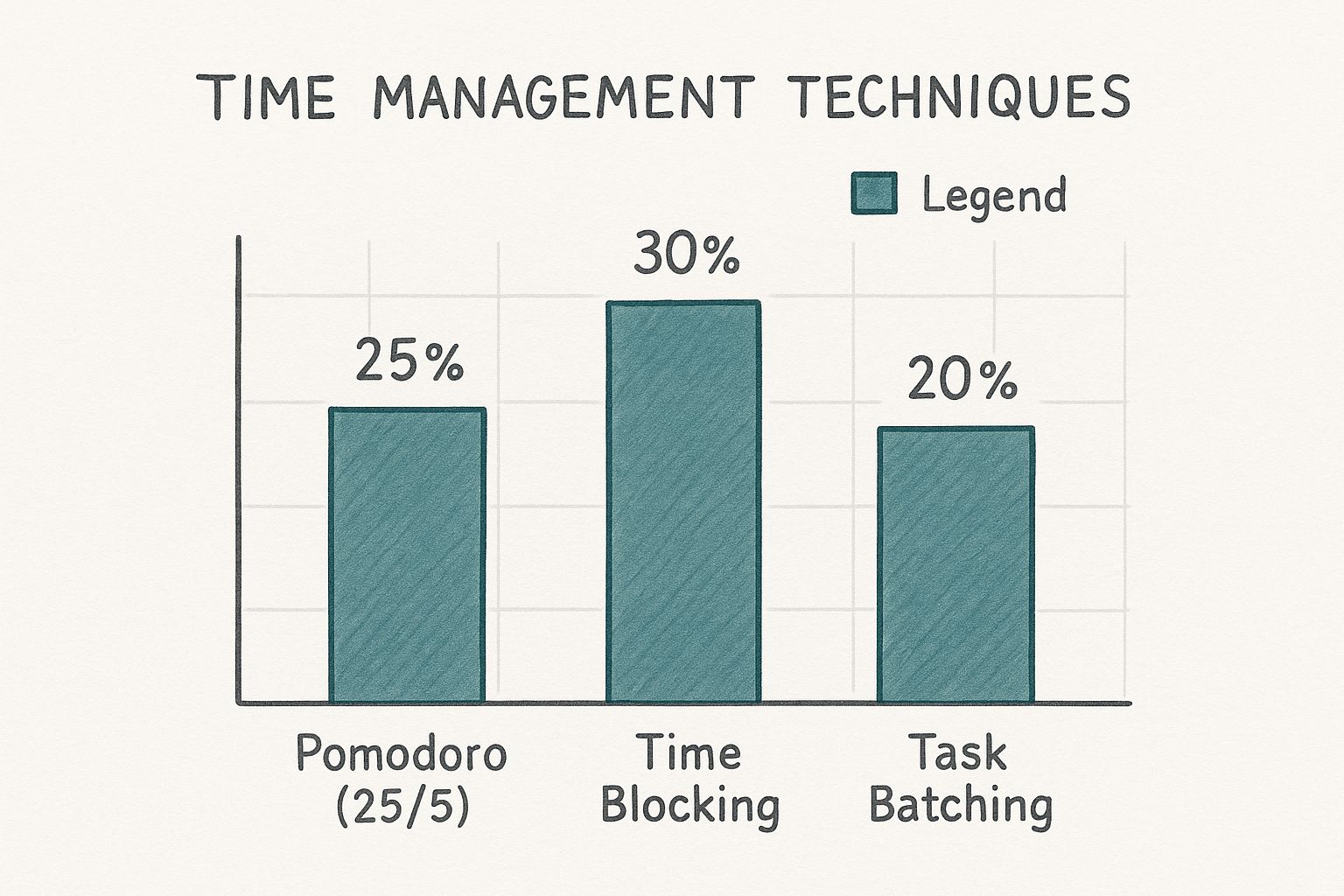
This just goes to show how a structured approach, backed by the right tech, can help you reclaim valuable time and focus.
There's a fine line between using technology effectively and just creating more noise. It's about being intentional with your choices.
Smart Tech Integration vs Tech Overload
The best approach is always a deliberate one, focused on solving real-world friction for your team.
Technology is a powerful partner when it automates the mundane, clarifies the complex, and gives your team back its most valuable resource: time.
Ultimately, the smartest tech choices are the ones that feel almost invisible. They fit so smoothly into your team's day that they simply remove friction and make it easier to get meaningful work done.
Design a Human-Centered Hybrid Work Model
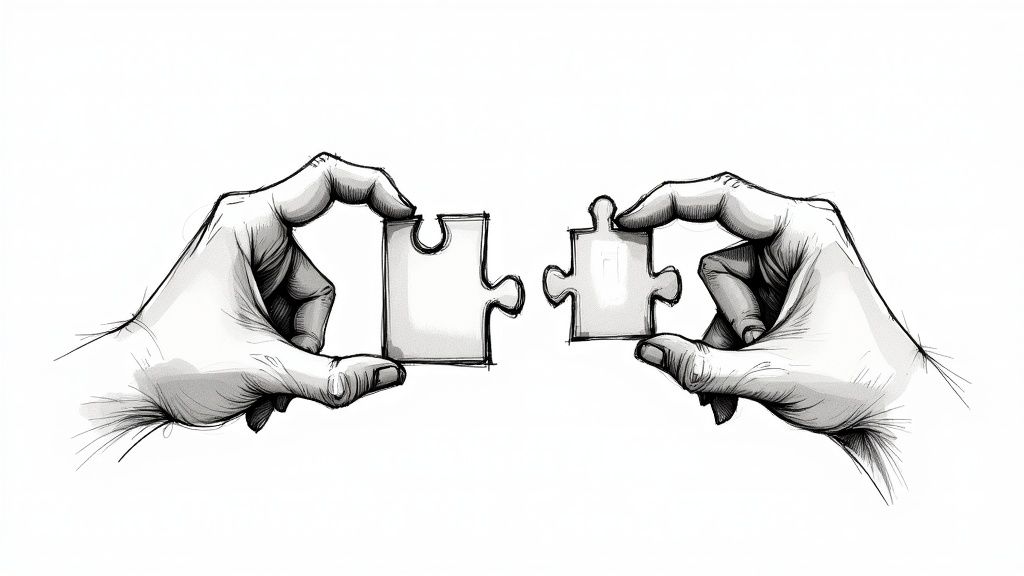
Flexibility isn't just a perk anymore; it's a core expectation. But a great hybrid work model doesn't just happen on its own. Without a clear and intentional design, it can quickly turn into chaos, leaving remote employees feeling isolated and in-office days feeling pointless. The real secret is to build a human-centered framework that finds the sweet spot between autonomy and genuine connection.
This approach goes way beyond just letting people work from home a few days a week. It forces you to rethink why and how your team comes together in the first place. When done right, a well-designed model can seriously improve team productivity by giving people the focused time they need while making in-person collaboration more meaningful.
Establishing Core Collaboration Hours
One of the trickiest parts of a hybrid setup is juggling different schedules, especially across time zones. The solution isn't to force everyone back into a rigid 9-to-5. Instead, the smart move is to establish core collaboration hours—a specific block of time each day when everyone agrees to be online and available for meetings or quick chats.
For instance, a team spread across the U.S. might set their core hours from 11 a.m. to 3 p.m. EST. This simple guideline respects individual flexibility while creating a predictable window for real-time work, which helps prevent those frustrating communication bottlenecks.
This strategy is all about creating overlap, not control. It gives your team the freedom to structure the rest of their day around deep work, appointments, or personal commitments, which is a massive driver of both satisfaction and output.
The goal of a hybrid model isn't to replicate the old office experience online. It's to create a better, more intentional way of working that leverages the best of both worlds.
Making In-Office Time Count
When your team does decide to come into the office, that time needs to be incredibly valuable. The last thing you want is for in-person days to become just another day of sitting on video calls, but with a longer commute. You have to structure these days around activities that actually benefit from being face-to-face.
Here are a few ways to make that office time more purposeful:
- Set a "Collaboration Day": Designate one or two days a week (e.g., Tuesdays and Thursdays) as the primary in-office days. This ensures people are actually there at the same time.
- Plan Purposeful Activities: Use the physical space for high-energy workshops, whiteboarding, and creative problem-solving that’s tough to replicate on a screen.
- Encourage Social Connection: Strengthen relationships with team lunches, social events, or collaborative projects that build genuine rapport.
- Host Project Kickoffs: Get everyone aligned and excited by kicking off major initiatives in person, where you can read body language and build shared momentum.
The data really backs this up. Research shows that employees with location flexibility have a 33% lower likelihood of quitting. This shows that supporting a well-structured hybrid model is a key factor in how to improve team productivity and keep your best people. You can dig into more employee productivity statistics and see the full picture of how flexible work is shaping today's teams on archieapp.co.
By being intentional about your hybrid model—setting clear expectations and making in-person time purposeful—you create a system that respects your team's needs and drives exceptional results.
Got Questions About Team Productivity?
Even with a solid plan, hitting snags when you're trying to boost team productivity is totally normal. Let's be real, the practical side of making these changes stick can be tricky. This section tackles some of the most common questions I hear from leaders.
My goal is to give you clear, no-fluff answers so you can move forward, handle common issues, and make sure these new habits actually last.
How Do I Measure Productivity Without Being a Micromanager?
This is a big one, and it's a concern that separates good leaders from the rest. The secret is to stop focusing on activity and start focusing on outcomes. Forget about tracking hours or watching every single click. Instead, look at the results. Are projects hitting their deadlines? Is the work quality where it needs to be? Are we actually achieving our goals?
To make this work, you need goals and metrics that are crystal clear to everyone on the team.
- Define What "Done" Means: Every single task needs a clear, agreed-upon definition of completion. This cuts out the guesswork and gives your team the freedom to work on their own terms.
- Make Progress Visible to Everyone: Use a shared tool, like your Notion workspace, where the status of every important initiative is out in the open. This kind of transparency builds accountability naturally, so you don't have to chase people for updates.
- Have Regular Check-ins (Not Interrogations): Hold quick, focused meetings to talk about progress and, more importantly, any roadblocks. These should feel like supportive huddles, not a pop quiz.
The whole point is to build a system based on trust and accountability, where your team feels empowered, not constantly watched.
True productivity measurement is about visibility, not surveillance. When the team's goals and progress are clear to everyone, the need for micromanagement just fades away.
What’s the Best Way to Keep Remote and Hybrid Teams Aligned?
Keeping a distributed team on the same page is probably one of the biggest challenges out there, but it's completely doable if you have the right systems in place. You have to be super intentional about your communication and create a single source of truth for everything important.
Don't let game-changing conversations disappear into a black hole of scattered Slack threads or endless email chains. You absolutely need a central hub for your projects, and a well-built Notion workspace is perfect for this. This is the one place your team should go for project briefs, task lists, deadlines, and key decisions. It stops information from getting siloed and ensures everyone is singing from the same hymn sheet, no matter what time zone they're in.
On top of that, you need to set clear rules for communication. Decide which tool is for what. For example, maybe Slack is for quick, casual questions, but all official task updates and feedback happen directly in your project management tool. A simple rule like this can slash confusion and keep everyone perfectly in sync.
Ready to stop juggling chaotic documents and build a single source of truth for your team? The Nora Template transforms Notion into a powerful, streamlined project management system designed to keep everyone aligned and focused. See how it can simplify your workflow and boost your team's productivity today.

.svg)
